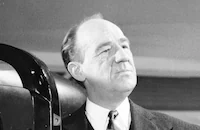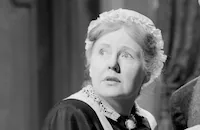El Cid
Brief Synopsis
Cast & Crew
Anthony Mann
Charlton Heston
Sophia Loren
Raf Vallone
Geneviève Page
John Fraser
Photos & Videos
Film Details
Technical Specs

Synopsis
In 11th-century Spain, the Christian kingdoms of Castile, Leon, and Aragon face the constant threat of the warring Moors and their determination to spread the Islamic culture throughout all of Europe. Into this arena of violence rides Rodrigo Diaz de Vivar, whose courage, wisdom, and spiritual strength earn him the sobriquet El Cid, or "The Lord." Following one particular battle, El Cid liberates some Moorish emirs on their vow never again to attack Castile. His act of mercy is misinterpreted as treason by Count Gormaz, the father of his beloved Chimene, and to protect the family honor El Cid is forced to slay the Count in a duel. Although Chimene vows to have her revenge, she is obliged to marry El Cid upon the bidding of King Ferdinand, but they do not consummate the marriage, and Chimene enters a convent. A short time later Ferdinand dies, and his kingdom is divided amongst his three quarrelsome children, Alfonso, Sancho, and Urraca. Before long, the weak, ambitious Alfonso arranges the assassination of Sancho. When El Cid refuses to vow allegiance unless Alfonso swears himself innocent of his brother's death, he is banished from Castile. But through the long years that follow, El Cid continues to battle the Moors, and his ranks increase as loyal subjects join him by the score. Eventually his noble nature wins over even Chimene, and she again declares her love for him. When the Moorish leader, Ben Yussuf, begins planning a massive invasion of Valencia, Alfonso recalls El Cid from exile and places him in charge of the army. For days the battle rages and on the eve of the last great Moorish onslaught El Cid is mortally wounded by a stray arrow. Attended by Chimene, he makes her promise that, alive or dead, he will lead the next day's charge. Obedient to her husband's wishes, Chimene has El Cid's dead body mounted firmly on his white charger and placed before his troops. And when the Moors see the seemingly invincible El Cid riding once more into battle, terror and confusion overtake them, and they flee in disorganized panic toward their ships.

Director

Anthony Mann
Cast

Charlton Heston

Sophia Loren
Raf Vallone
Geneviève Page
John Fraser
Gary Raymond

Hurd Hatfield
Massimo Serato

Herbert Lom
Frank Thring
Douglas Wilmer

Michael Hordern

Andrew Cruickshank
Tullio Carminati

Ralph Truman
Christopher Rhodes
Gérard Tichy
Carlo Giustini
Paul Müller
Katina Noble
Fausto Tozzi

Barbara Everest
Franco Fantasia
Crew
Ben Barzman
Manuel Berenguer
Samuel Bronston
Samuel Bronston
Edna Bullock
Yakima Canutt
Leon Chooluck
Veniero Colasanti
Veniero Colasanti
Grazia De Rossi
Stanley Detlie
Jack Erickson
Verna Fields
Fredric M. Frank
Fredric M. Frank
Carl Gibson
Robert Krasker
Norton Kurland
Robert Lawrence
José López Rodero
Guy Luongo
Gordon K. Mccallum
Pat Miller
John Moore
John Moore
Gloria Mussetta
José María Ochoa
Maciek Piotrowski
Jaime Prades
Miklos Rozsa
Miklos Rozsa
Luciano Sacripanti
Jack Solomon
Mario Van Riel
Michael Waszynski
Paul Francis Webster
Alex Weldon
Philip Yordan

Photo Collections
Film Details
Technical Specs

Award Nominations
Set Decoration
Best Music, Original or Comedy Series
Best Song
Articles
El Cid (The Collector's Edition) - THE COLLECTOR'S EDITION OF EL CID - Anthony Mann's 1961 Epic Starring Charlton Heston
El Cid tells the story of Spain's most famous hero, Rodrigo Diaz de Vivar (Charlton Heston, in one of his best performances), who in the eleventh century transformed himself from ordinary man into mythic warrior hero by bravely, intelligently and compassionately fighting to end Spain of its constant battles between Christians and Moors, and working to unite one and all as Spaniards. One of the first images in the film is of Rodrigo carrying a cross through a war-torn village, and the Christ-like implications are not out of place; he will come to be seen as a savior by his countrymen. Soon thereafter he spares the lives of some captured Moors, who, awestruck by his compassion and wisdom, anoint him "El Cid" (meaning "Leader, Chief").
For the Christian rulers, however, Rodrigo's actions deem him a traitor. To keep his honor, he fights and kills the king's champion warrior, who happens to be the father of Rodrigo's beloved Jimena (the impossibly hourglass-shaped Sophia Loren), whom he was about to marry. Jimena vows to avenge her father's death even though it's plain she still loves Rodrigo. Meanwhile, it is agreed that Rodrigo will settle a political squabble over control of a city by jousting with the champion of a neighboring king. If he wins, Rodrigo will also clear himself of the charges against him. This is all just the beginning of an epic tale, spanning many years, which works beautifully well because of the way it balances a small human story with a wider historical tale. Also in the cast are Hurd Hatfield, Italian star Raf Vallone, Genevieve Page as a princess with a seemingly incestuous relationship with her brother Alfonso (John Fraser), and Herbert Lom as the evil Moor, Ben Yussuf.
In the end, El Cid is about leadership, and what it means to be a leader (or king, or president), thereby ensuring the film's continued relevance to modern audiences. The picture may have some overly melodramatic romantic scenes, but in a movie in which everything is big, an overwrought romance isn't too much of a problem.
One of the simple-yet-brilliant aspects of El Cid's screenplay (by Philip Yordan, Fredric M. Franc and uncredited Ben Barzman) is that its battle scenes start small and build up, avoiding the problems of, say, the Lord of the Rings trilogy, which have an overload of enormous battles in each film. Over its 188-minute running time, El Cid has five major fight scenes (with a few others tossed in) expanding in size and scope along the way. The picture begins, however, with the aftermath of a major skirmish. The ruined village tells us something about the scale of the battle, thereby smartly and instantly establishing the epic nature of the movie overall, but the first fight we actually see is an indoor swordfight between two men. It's amazingly choreographed and composed; the weight of the broadswords is easily sensed, and the clanging of the metal is heightened powerfully.
The second battle is a joust: still two people, in other words, but outdoors and on a bigger scale. It's one of the most thrilling scenes in the movie and took five weeks to shoot despite its 10-minute length. The third battle is a short clash between El Cid's small party of men and a group of Moorish soldiers. The fourth is an awesomely-staged fight between El Cid and 13 men, and the fifth is the epic battle of Valencia with thousands of soldiers, which climaxes the film. One interesting aspect of this final battle is the skillful way in which the screenwriters and director manage to draw out its epic buildup; they give us the huge spectacle of armored soldiers and horses and wooden machinery approaching the battleground, but when they arrive, there's quite a long dramatic standoff, as well as rebellion inside the fortified city, before the final battle itself begins.
While the action scenes are expertly staged by Mann, the quieter scenes have just as much impact. Mann was as fine a director of actors as he was of action - not just in terms of the actors delivering good performances and dialogue, but in terms of photographing them so that their composition in the frame tells story. One of Mann's trademarks was his mastery of creating tension by using the extreme foreground and background of the frame simultaneously, or in the same shot. For example, at the end of one long-shot pan of El Cid's men riding their horses through a rocky pass, Mann shows the arm of a hidden bad guy holding a sword in the extreme foreground. This jolts the audience, creating an apprehension which matches the tone of the scene. Mann also uses sound viscerally, is in the aforementioned metallic clanging, or just in allowing us a moment to hear the sound of wind entering a chapel.
El Cid is the first release from new Weinstein Company DVD label "The Miriam Collection," which has more Bronston-produced films on the way including Anthony Mann's The Fall of the Roman Empire (1964). From the label's name to the superior digital transfer and the overall high quality of its product, The Miriam Collection is obviously trying to establish itself in the same company as The Criterion Collection, and to that end there are many generous extras included on both the "limited" and "collector's" editions of this DVD.
The collector's edition comes with six lobby card reproductions, a reprint of a 1961 comic book version of the movie, and a reproduction of the original souvenir program. This is filled with great photos from the film, which together with captions tell its story from beginning to end. Mixed in are longer articles about the production and cast and crew, with backstories on the castles used, historical research conducted, and sets built. (1700 Spanish Army troops and 500 Madrid Municipal Honor Guard riders were used as extras.)
Additionally, both the limited and collector's editions contain the following extras:
There's an audio commentary track from Samuel Bronston's son Bill, and Bronston biographer Neal M. Rosendorf. They generally cover the historical content more than the film's nuts-and-bolts craft (i.e. the writing and direction), and unsurprisingly deal much more with Bronston than with Mann. Also included are five well-edited and -produced documentary featurettes. The ones on the making of El Cid (24 minutes) and on Anthony Mann (17 minutes) feature various historians including Rosendorf and Jeanine Basinger (who wrote the only book-length study of Mann), Barzman's widow Norma, Mann's daughter Nina, and archival interviews with Philip Yordan, Charlton Heston and Mann himself. (Alas, no Sophia Loren.) The making-of featurette even includes brief interviews with El Cid's film editor, production manager, script supervisor and key grip!
Editor Robert Lawrence points out, "If you look, you'll see very few medium shots. They're either big wide shots or big close-ups." Yordan says El Cid was the only worthwhile thing he and Mann ever made. He's crazy - the pair also collaborated on Reign of Terror (1949), The Man From Laramie (1955) and Men in War (1957) among others. Mann talks about why actors are more truthful on location than in a studio, and about violence in his films.
Kudos to the Weinstein Company for unearthing these fascinating interview snippets. Mann is a filmmaker beloved by serious film students and historians, and his movies stand the test of time. The documentary reveals him to have humble origins and a childhood lacking in much education. Nonetheless, he rose to great heights in his profession by starting small, directing tiny-budgeted films, and moving up through modestly-priced films noirs, A-list westerns and action films, and finally to enormous spectacles, generally building on his own techniques all the while. He figured out in the cheapie films how to find moments he could make pictorially interesting; as he was given better scripts and budgets, he was able to apply his visual sense to more and more of the movie, eventually turning out perfectly realized films like The Naked Spur (1953) and Men in War. Mann's later westerns, like The Man From Laramie and The Last Frontier (1955), possessed a somewhat epic quality, and it was only natural that true epics would follow. (Mann's eye for widescreen photography was as good as anyone's in the business.) After a rocky experience on Spartacus (1960) marked by a falling-out with star-producer Kirk Douglas and a replacement by Stanley Kubrick, he was offered El Cid and made the most of it.
The documentaries also delve into Heston and Loren's contentious professional relationship and the staggering historical research done for the film. Bronston fancied himself a larger-than-life showman who spared no expense, but he was truly interested in an accurate reproduction of the era. Every costume and piece of armor and even floor tile was faithfully rendered; Heston's sword was made from the same foundry as the real El Cid's sword centuries before. El Cid was made for $7 million, on the high end of average for an epic at the time, largely because Bronston was able to shoot at the castles for free.
The other featurettes are a 52-minute biography of Bronston, a 7-minute interview with former Technicolor employee and preservationist Gerry Byrne (who says he has "looked after" the Bronston film library for many years), and a loving 30-minute profile of composer Miklos Rozsa which includes an audio interview with Rozsa himself. Rozsa was an interesting man, and El Cid was his last epic score as well as one of his richest. He composed it in a house in Spain provided by Bronston for that purpose.
Finally, there are stills galleries, trailers for both the original 1961 release and the 1993 reissue, radio interviews with Heston and Loren from 1961, and a written introduction by Martin Scorsese, who writes of the film's "unusually dark textures" and "powerful sense of the old world - it has a solidity and presence that simply wouldn't be possible today. CGI leads to a certain thinness of texture, which is diametrically opposed to the visual force you see here, possible only with thousands of extras and grand expanses of space at your disposal."
El Cid was a smash hit at the box office, earned three Oscar nominations (art direction, song and score), and was Samuel Bronston's most successful picture. It's perfectly presented here; just do yourself a favor and watch it on a giant widescreen TV.
To order El Cid, go to TCM Shopping.
by Jeremy Arnold

El Cid (The Collector's Edition) - THE COLLECTOR'S EDITION OF EL CID - Anthony Mann's 1961 Epic Starring Charlton Heston
Quotes
Trivia
By the time this was released, Allied Artists (formerly Monogram) had ceased production and were only distributing independent productions. The rights for the Western Hemisphere were acquired from Samuel Bronston. This gave Allied Artists their only full-blown epic which was given a roadshow presentation followed by a general release.
Notes
Copyright length: 181 min. Filmed in Madrid and Rome. Released in Italy in 1961; running time: 176 min.

Miscellaneous Notes
Producer Samuel Branston won a Special Merit Award at the 1961 Golden Globes.
Voted One of the Year's Ten Best Films by the 1961 New York Times Film Critics.
Released in United States 1993
Released in United States January 1994
Released in United States Winter December 1961
Re-released in United States September 20, 1993
Shown at Palm Springs International Film Festival January 6-16, 1994.
Screenwriter Ben Barzman was uncredited due to being blacklisted, and had his credit returned in 1999.
Re-released in Paris July 3, 1991.
Super Technirama 70
Released in United States 1993 (Shown at AFI/Los Angeles International Film Festival (Opening Gala) June 10 - July 1, 1993.)
Released in United States January 1994 (Shown at Palm Springs International Film Festival January 6-16, 1994.)
Re-released in United States September 20, 1993 (director's cut)
Released in United States Winter December 1961













